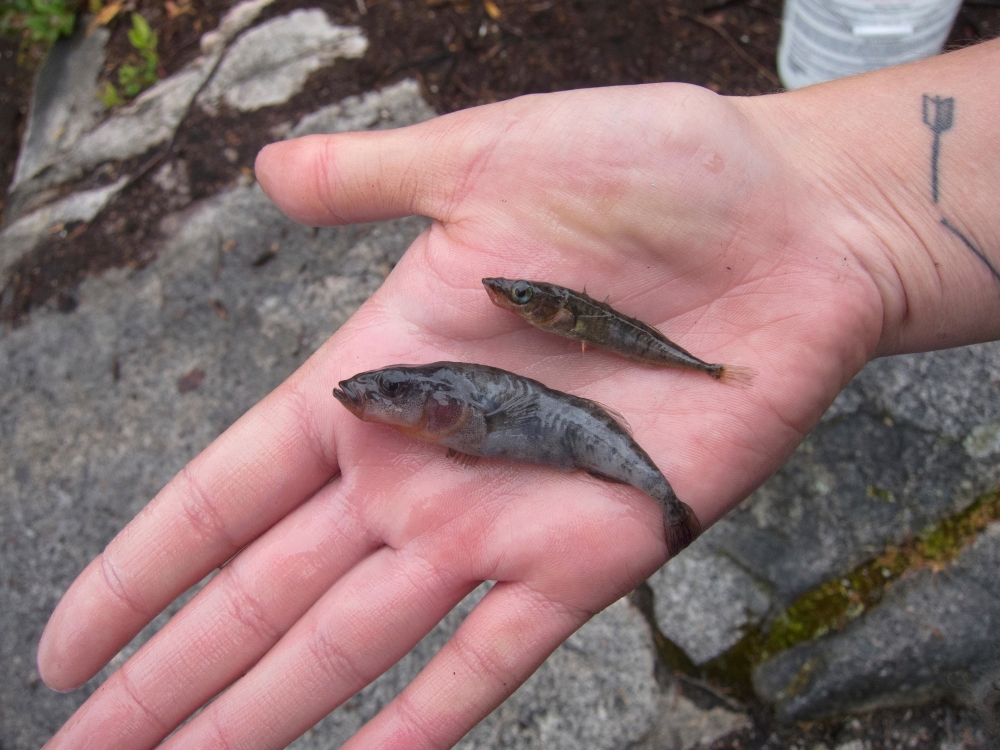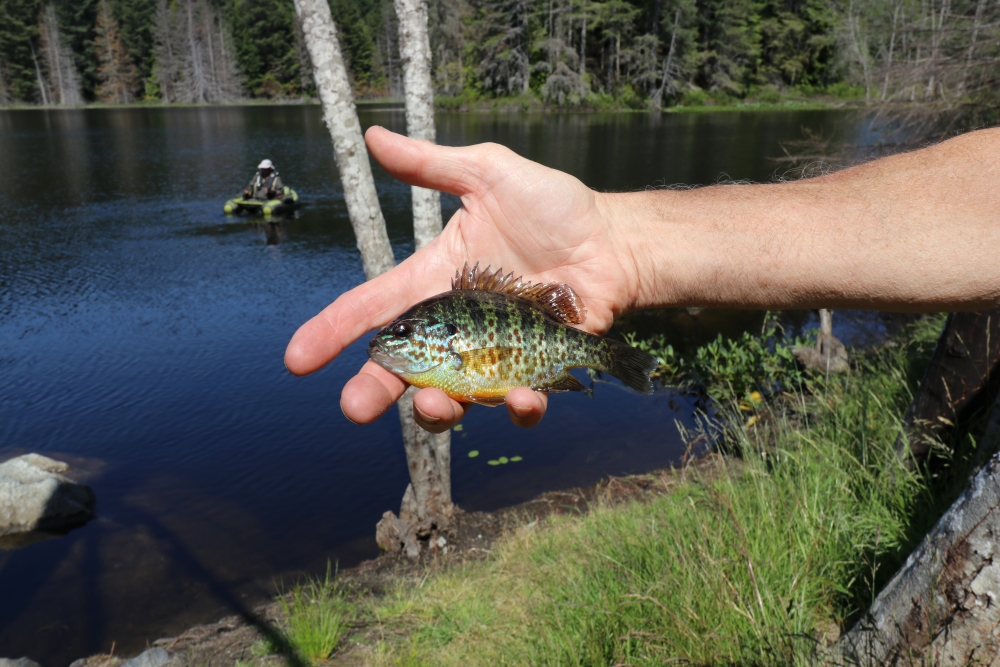Twice a day, John Dafoe reaches into Trout Lake, where six traps are waiting for him. At 7 a.m. and 7 p.m., he will pull up traps teeming with up to 50 live fish.
These are the pumpkinseed sunfish, an invasive species stirring up concern for Sunshine Coast aquatic ecosystems. The fish has a sparkle of colours that make them almost look tropical or like a colourful perch, as Dafoe points out.
The fish, native to eastern North America, can be considered a nuisance species, according to the Department of Fisheries and Oceans website. They eat amphibians and small fish alike and can reach high densities, competing with native fish. They may also have disastrous consequences for local aquatic celebrities: stickleback.
Pumpkinseed sunfish contributed to the demise of stickleback populations on Vancouver Island.
Dafoe, a 52-year resident of the Sunshine Coast who has been fishing since he could hold a rod, has been raising the alarm and strategizing a solution with a group of fishers, scientists and researchers.

World famous fish
One of the native species in Trout Lake is the threespine stickleback, a new species — one of the youngest on Earth — that appeared since the last glaciation and has been extensively studied on the Sunshine Coast.
Stickleback pairs are “actually what the Sunshine Coast is most famous for, believe it or not,” Michael Jackson, the executive director of the Loon Foundation, said in a July 4 interview. They were discovered here.
Years ago, a University of British Columbia professor, Don McPhail, found populations of sticklebacks in Sunshine Coast lakes that turned out to be the discovery of two different species, evolved from the same marine ancestor. He repeated that discovery in other local lakes, then the Loon Foundation embarked on a quest to check the 21 lakes on Nelson Island to continue the work of the professor.
When the two species, benthic and limnetic, exist in the same lake they are called pairs. Together, they exhibit adaptive radiation: different traits and habits that have developed over time. Each lake’s population is different.
“This is actually evolution in action,” Jackson said.
“These are such special fish,” studied around the world and the focus of a conference every four years, Jackson said. Teams in the U.S. are studying the stickleback pairs’ relation to cancer.
In Trout Lake, there is only one kind of stickleback, and it is threatened by what could be hundreds of thousands of pumpkinseed sunfish. Their small mouths can devour sticklebacks, especially their young.
Invasives interfere with research
Dolph Schluter, a professor in the zoology department at UBC and the former director of the biodiversity research centre, has spent years studying sticklebacks as an example of the origin of species, and how species evolve and adapt to new environments. Sticklebacks are common in small coastal B.C. lakes, he said, where trout has adapted to eat them.
“The impacts of introduced species on native species reverberate through the food web,” Schluter told Coast Reporter.
On May 31, Schluter was gathering samples of stickleback from Little Quarry Lake on Nelson Island when Dafoe invited him to Trout Lake, telling him the invasive species had been introduced. Two hours later, their traps were full of pumpkinseed sunfish, but no stickleback.
“My heart dropped,” Schluter said.
“I think it's the first occurrence [of pumpkinseed sunfish] on the Sunshine Coast. So it would seem that they would have to come from a long distance and that, to me, suggests that it was deliberate rather than accidental,” Schluter said. It could have been inadvertent, but humans were likely involved.
For Dafoe, “It was a new alarm.”
The sticklebacks are small, and easy to overlook, Schluter said. The scientist has two points of view on the presence of pumpkinseed sunfish in Trout Lake.
Schluter uses Trout Lake’s population of stickleback as a comparison to other lakes that have two stickleback species. The introduction of an invasive species could mean he’s not able to continue to use that population for his research. So far, the number of stickleback in Trout Lake are down. Schluter said it’s possible they’re avoiding the traps, where sunfish are also being caught.
On the other hand, the scientist hopes to get a sample of the Trout Lake stickleback to see if they evolve in response to the presence of pumpkinseed sunfish.
When were they introduced?
Dafoe said someone likely introduced pumpkinseed sunfish in the lake sometime in 2021. “But we don’t need to know who, because it’s done,” he said. Instead, he wants to focus on the biggest risk: the invasive species spreading to other channels and waterways.
On June 28, Dafoe was notified that pumpkinseed sunfish were discovered in Sargeant Bay Provincial Park’s Colvin Lake. Dafoe said their presence appears to be moderate and may be manageable between otters, birds and the Sargeant Bay Society’s trapping strategies. Jackson explained the invasive species can travel to other unconnected waters when eggs become attached to the feathers of waterbirds or on plants.
The professor is also concerned for native species. Sticklebacks are “part of the balance of the lake,” which is home to other species as well, Dafoe said. The lake’s namesake trout will also have less food, because the sunfish eat anything they can and reproduce faster.
Trapping the problem
The pumpkinseed sunfish are biting now, Dafoe said, and susceptible to trapping. As of late June, Dafoe has been setting and emptying traps nearly every day to “take a big bite out of” the problem.
“It’s going to be a stopgap measure to bring the population down and let nature be nature,” Dafoe said. He hopes to target the next generation of juveniles, then will turn his focus to catching the adults to cut into breeding. “We’re really trying to get them all.”
While Dafoe has suggested fishing the pumpkinseed sunfish out of existence locally, the problem may be beyond that now, and they’re easily spread. He worries that it may become a regional issue.
Jackson, who has years of experience with stickleback research, restoring lake systems and controlling fish populations, said restoring a lake’s ecosystem after an invasion is a huge undertaking that can take years. To find a way to save the sticklebacks, the native species could be relocated to a different lake. Emptying the lake or using poison is out of the question, he said, but there could be success by estimating how many pumpkinseed sunfish are in the lake. By trapping, marking and recapturing, researchers could see just how big the invasive population is in Trout Lake.
“What you need is a concerted effort to look into this with more detail, and definitely try to prevent anybody else from putting these things in a different lake,” Jackson said.
“People just have to take care of what we have and just realize this is a very, very special place.”
Schluter said the first step to take is to inform the public.
The group has a permit to trap in Trout Lake, and is looking for equipment and volunteers interested in helping, Dafoe said. Fishers are encouraged to catch the invasive species.

An edible nuisance
During Dafoe’s interview next to Trout Lake on June 22, a long-time fisherman paddled by in his one-person inflatable. Though he typically catches trout, he has recently turned his attention to the species that threaten their ecosystem. As he cast his line, it was quickly answered with a bite. He pulled up a pumpkinseed sunfish, which he passed over to Dafoe.
The fisherman has been on a mission to kill as many of the sunfish as he can. Hook and line will help catch the bigger fish, Dafoe said. Dafoe was encouraged to find two young fishers catching the pumpkinseed sunfish on a recent visit to the lake, and took it as a sign that awareness and interest is growing.
For those who catch pumpkinseed sunfish, Dafoe says they can be used as wildlife rehabilitation food, compost (his favourite option) and as food for people and pets. The fisherman told Dafoe he ate one for dinner the night before. Dafoe has heard they’re a pretty bland fish, though could make a good broth, but he hasn’t bitten into one yet.
“It’s a wide open invite: Go fish, and don’t put them back in the water,” Dafoe said.

